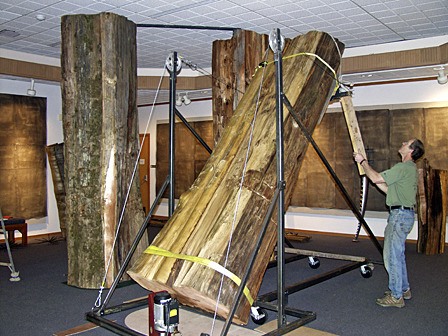By now, most islanders will have noticed artist Todd Spalti’s enormous bird perched in downtown Eastsound.
It was installed earlier this summer in front of the Orcas Island Historical Museum, is over 14 feet tall, and weighs 2,000-plus pounds. The sculpture was designed to demand attention, to draw people into the museum, and to promote the idea of making works by local artists available to the public.
The sculpture will be officially dedicated on Saturday, Oct. 9 at 1 p.m. Traditionally, the museum has held a closing party in early October. Now that they stay open on Saturdays all year, it was to be an end-of-season party. Instead, this year they will combine the two events. Fresh-pressed apple cider will be served along with tasty treats. Spalti will give a short talk at 1:30 p.m., covering how he got the giant cedar log to Orcas Island, and his experiences during the carving.
Fellow artist and islander Susan Singleton calls it “a wonderful welcoming anchor in Eastsound — it captures a combination of our community’s reverence for Native American roots and our love of nature.”
Reaction from the community has been very positive, so much so that Spalti — a low-key, non-temperamental artist — says he hesitates to come into Eastsound because so many friends stop their cars to tell him how much they like the sculpture.
The idea of Spalti creating a large piece to be placed near the museum has been hatching for years, but only became serious in early 2009 when a patron stepped forward. Together, they considered and rejected various designs until the day that Spalti, inspired by a Salish carving he saw and a little-known creation myth, sketched out what become the final design. He was determined to combine Native and non-Native, ancient and modern, and the final work is truly unique. The piece is named “Tribute. It’s a tribute to Native American art and culture, to the beauty of our area, and to the many artists who inspired him.
The huge piece had its challenges. The shape and weight of the wood forced changes as he proceeded.
“I usually have the design figured out before I start, and then I just do it, but this just wasn’t going to happen,” Spalti said. “I worried it over for months. Curves and shapes were sometimes dictated by what I found in the wood. I work with tolerances often less than 1/16 of an inch, which is tough with this size and weight.”
Spalti comes from the tiny hamlet of Pleasantville, Iowa. As long as he can remember, he has been drawing, carving, or painting. He entered design school at Iowa State in 1977, but didn’t find much inspiration there, so he left school and hit the road with his brother, driving west until they hit the Oregon coast. They settled in Corvallis, where they worked as carpenters and on a wildlife refuge.
In 1981, Spalti got a job as a counselor at Camp Four Winds.mThere he encountered the carvings of Ernest Norling and, more importantly, his future wife Jean Mashburn (Spalti). Other influences were the Northwest scholar and artist Bill Holm, carver and scholar Steve Brown, and artist/iron-worker Richard Serra. Spalti has works in collections from Orcas Island to Paris, France.
In addition to being a woodworker, cabinetmaker, and metalsmith, Spalti is also an accomplished painter. But lately he has gravitated toward larger work.
“My work has become more minimal over the years while it has also grown in scale,” he said. “There is a power in old growth trees or in a dry canyon at dusk; in my work, I try to capture a small bit of the essence of this power.”
Spalti is now working on a large metal octopus for the Lambiel Museum.



